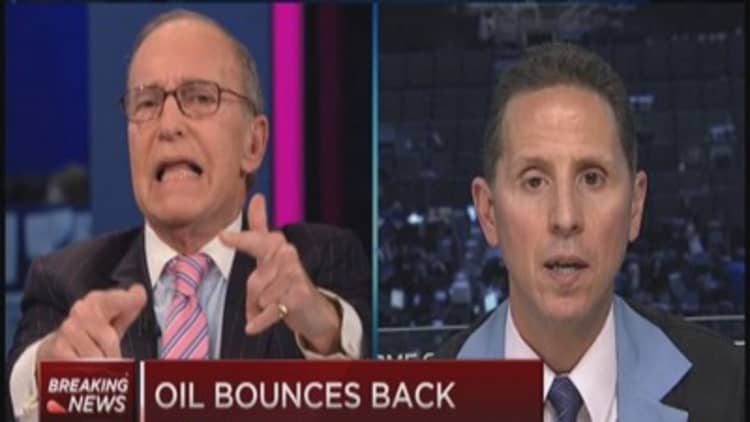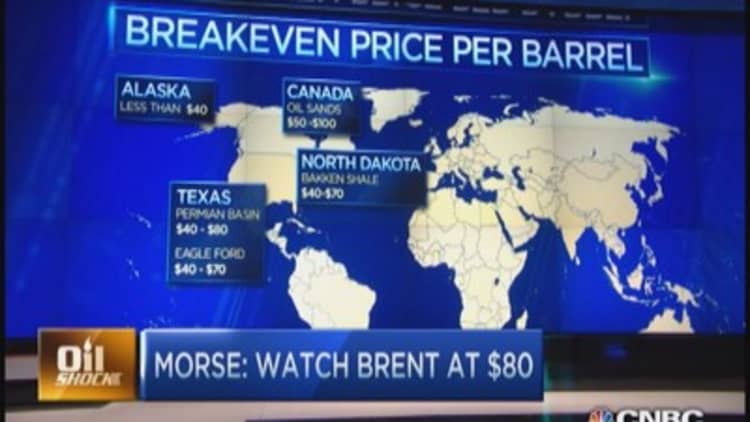
It would take a drop in crude prices to about $50 a barrel before U.S. oil production growth would be choked off.
That's the finding in a new report from Citigroup energy analysts. They said the two-year low in U.S. oil prices is not yet stalling growth of U.S. crude production, and even at $70 per barrel, the industry would continue to increase production.
It would have to fall to $50 or even lower, to fully halt shale production growth, the report said. At a level of $40 to $60 a barrel, production growth would fall toward zero as producers shut less productive wells. Citi said, in fact, this break-even price could get lower over time as producers focused on more intensive drilling in more productive areas.
The rapid growth in U.S. oil production has been a sore point for OPEC and other producers, as it has contributed to a glut of supply in the Atlantic basin at a time when global demand growth continues to slide. West Texas Intermediate futures briefly fell below $80 a barrel Thursday, a new two-year low.
Saudi Arabia, the world's largest producer, took aim at the problem of falling prices when it decided to defend its market share by cutting prices instead of production. Traders have speculated the Saudis intention was to hurt any number of rivals including Russia, Iran or the U.S. shale oil industry.
Read MoreNew Saudi reality: OPEC is no longer a reality
"I have no way to know the validity of Saudi motivation. Certainly, officials from the kingdom have made it clear that they think that at prices under $90 a barrel, U.S. shale production begins to slide," said Edward Morse, global head of Citigroup commodities research.

"Even if the price of WTI were at $70, the U.S. would still be increasing crude production—if not by a million barrels a day per year, then maybe by 750,000 barrels a day per year. I think if the Middle East guys have this in mind, they're going to be surprised by the kind of gritty robustness of the U.S. production business."
U.S. oil production is about 8.8 million barrels a day, about a million barrels higher than this time last year, according to the latest government data. Saudi Arabia is producing about 9.6 million barrels a day.
Citi analysts broke down well break-even prices in their analysis. U.S. production costs vary greatly by region and within regions, depending on the wells. Citi says in the Eagle Ford basin in Texas, for instance, a higher producing well might have a break-even price of $60, while another would be lower producing at $80 a barrel.
Morse, speaking on CNBC's "Halftime Report," also said oil may have found a temporary bottom. WTI was trading at $83 per barrel at midafternoon.
"It's hard to pick a bottom. I think for the time being, we're sort of at the bottom," said Morse. "The big fundamental issue is that the only buyer of crude in the world is the refinery. Refinery demand for crude is way down because refineries around the world are in maintenance. Demand for crude right now is about 2.7 million barrels a day below where it was in the month of August."
Morse said in the next six weeks, refineries will come back into the market and demand could increase by about 3 million barrels a day.
"I would not be surprised to see a bump up in Brent and WTI as a result," he added.
Earlier, Morse told reporters on a conference call that forward futures contracts are signalling that prices are expected to be higher for both WTI and Brent. "I don't think we should draw the conclusion that because we had this abrupt fall in prices that it won't come to an end. It may be bottoming now. It may have further legs to go, but it won't go on forever," he said.


